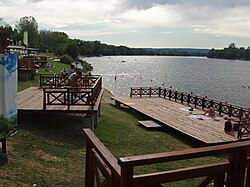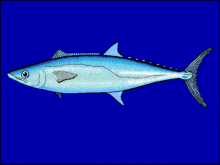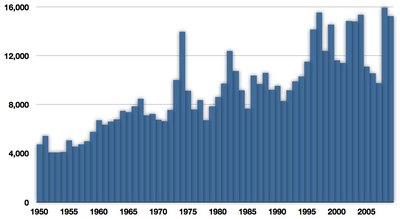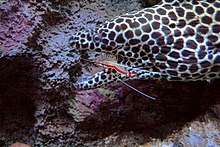The
Alligator Gar ("Gator Gar"),
Atractosteus spatula, is a primitive
ray-finned fish. Unlike other
Gars, the mature Alligator Gar possesses a dual row of large teeth in the upper jaw. Its name derives from the
alligator-like appearance of these teeth along with the fish's elongated snout. The dorsal surface of the Alligator Gar is a brown or olive-color, while the ventral surface tends to be lighter. Their scales are diamond-shaped and interlocking (
ganoid) and are sometimes used by
Native Americans for jewelry and arrow heads.
Along with its status as the largest species of Gar, the Alligator Gar is the largest exclusively freshwater fish found in North America, measuring 8 to 10 feet (2.4 to 3.0 m) and weighing at least 200 lb (91 kg) at maturity. Kenny Williams, from
Vicksburg, Mississippi, has broken the record for largest Alligator Gar ever caught using a net.
[1] He caught the fish on February 14, 2011; it measured 8 ft 5 in (2.57 m) long, 327 lb (148 kg) in weight, and nearly 48 in (120 cm) around. The fish is believed to have been between 50 and 70 years old, wildlife officials said. Williams has donated the fish to the
Mississippi Museum of Natural Science in
Jackson where it will be on permanent display in the future.
The current world record for the largest Alligator Gar caught on rod and reel is 279 lb (127 kg).
[2] The largest taken by
bowfishing is 365 lb (166 kg).
[3] The fish is also known for its ability to survive outside the water, being able to last for up to two hours above the surface.
Distribution
Natural
Alligator Gar are found in the Lower Mississippi River Valley and Gulf Coast states of the Southern United States and Mexico as far south as Veracruz, encompassing the following US states:
Texas,
Oklahoma,
South Carolina,
North Carolina,
Louisiana,
Mississippi,
Alabama,
Tennessee,
Arkansas,
Missouri,
Florida, and
Georgia.
[4] They have also been known historically to come as far north as central Kansas, Nebraska, Kentucky, Ohio, Iowa, and west-central
Illinois, where the most northerly verified catch was at
Meredosia, Illinois in 1922 and an 8.5 ft (2.6 m) specimen, now preserved, was caught at nearby
Beardstown.
[5] Specimens at locations further south in Illinois have been verified as recently as 1976, with the Illinois Academy of Sciences verifying a total of 122 captures to that date.
[5] They inhabit sluggish pools and backwaters or large rivers, bayous, and lakes. They are found in fresh, brackish and
saltwater, and are more adaptable to the latter than are other gars. In
Louisiana it is common to see these large gar striking the surface in brackish marshes.
Outside natural range
There have been a few notable sightings of Alligator Gar outside North America.
In February 2007, a 1.5 m (4.9 ft) Alligator Gar was found swimming in
Jakarta,
Indonesia, when that city was hit by a major flood (see External Links below). In January 2008, a 3 kg (6.6 lb) alligator gar was found by fishermen in
Bera, Pahang,
Malaysia, when it was entangled in a fishing net.
[citation needed]
In November 2008, a 0.5 to 0.6 m (1.6 to 2.0 ft) long Alligator gar was caught in the north of
Esenguly,
Turkmenistan by two officials of Turkmenistan Fishery Protection. Dr. R. Mayden,
Saint Louis University and Dr. Eric Hilton,
Virginia Institute of Marine Science confirmed that it was probably
Atractosteus spatula.
[6]
On September 4, 2009 a 1 m (3.3 ft) long Alligator Gar was found in Tak Wah Park in
Tsuen Wan,
Hong Kong. In the next two days, at least 16 other Alligator Gars, with the largest one measuring 1.5 m (4.9 ft) long, were found in
ponds in public parks in Hong Kong.
[7] As reported by nearby residents, the fish were released in the ponds by
aquarium hobbyists and had lived there for some years. However, after a complaint made by a citizen who falsely identified the fish as
crocodiles, terms like "Horrible Man-eating Fish" were found in the headlines of some major local newspapers.
[8] Government officials decided to remove all the fish from the ponds as they claimed the species had no conservation value and would affect the local ecology if left in the ponds. The Leisure and Cultural Services Department said it would offer non-dangerous fish to animal welfare groups and
charities. The fish that was caught first died later that day, and claims have been made that the local government does not treat the gars in an animal-friendly way - they were seen catching the fish with improvised nets and garbage cans.
[9] On September 6 the government euthanized all of the fish as it said that there were no organizations willing to take them.
[10] On September 8 however, the
Hong Kong Ocean Park announced that it was willing to take the fish for exhibition and education to the public. Five surviving gars, caught on September 7, were sent to the Ocean Park.
[citation needed]
On January 21, 2011, 1.5 m (4.9 ft) Alligator Gar was caught at a canal in
Pasir Ris,
Singapore by two recreational fishermen. The fish was taken to a nearby pond where the owner confirmed it as an Alligator Gar, not an
Arapaima as the men initially thought.
[11]
Alligator Gars have also recently become "trophy" fish for private aquariums, particularly in
Japan. In June 2011, a group of men from Florida and Louisiana were indicted on charges of illegally removing wild gar from the
Trinity River in Texas and attempting to ship the fish to Japan at the behest of private collectors. It is alleged that the largest of the fish could have fetched $40,000 in the Japanese black market.
[12]
Behavior

10 feet (3.0 m) alligator gar caught at Moon Lake, Mississippi in 1910
[citation needed]
Feeding
The Alligator Gar is a relatively passive, solitary fish that lives in fresh and brackish water bodies in the southern U.S. It is
carnivorous and feeds by lurking amongst reeds and other vegetation, ambushing prey.
[13] Alligator gar have often been suspected in attacks on humans
[14][unreliable source?], but none of these attacks have been officially confirmed to be the work of this species.
Breeding
Though the Alligator Gar prefers slow-moving waters of rivers, bayous, and oxbows throughout most of the year, it appears to need spring time inundated floodplain fields or wetland vegetation in order to spawn.
[13]
Taxonomic history
Until relatively recently all gars have generally been classified in the genus
Lepisosteus Lacépède, 1803. The Alligator Gar had been given the name
Atractosteus adamantinus by the eccentric
Constantine Samuel Rafinesque-Schmaltz in 1818, and for a long time
Atractosteus was simply viewed as a junior synonym of
Lepisosteus.
E. O. Wiley resurrected this genus in 1976, in his work
The phylogeny and biogeography of fossil and Recent Gars.
Based on Wiley's work, after 1976 the Gars were officially split into
Lepisosteus and
Atractosteus, and ever since then zoos, aquarium books, anglers, and so on have been gradually catching up with the proper terminology.
Human usage
Sport fish

This six-foot 129 pound Alligator Gar was caught in the
Brazos River in Texas
Oklahoma, Texas, Arkansas, Mississippi, and Louisiana allow regulated
sport fishing of the Alligator Gar.
The fish is popular amongst
bowfishers because of its size and tendency to brawl. An interesting anatomical feature of this fish is that its buoyancy bladder is directly connected to its throat, giving it the ability to draw in air from above the water. For this reason, Alligator Gar are often found near the surface of a body of water.
Food source
In several Southern U.S. states, Alligator Gar are served in restaurants and considered a delicacy or novelty food akin to the American Alligator or crocodile.
Aquaria
Despite their large adult size, Alligator Gar are kept as
aquarium fish, although many fish labelled as "Alligator Gar" in the aquarium trade are actually smaller species. This fish requires a very large aquarium or pond and ample resources to keep. They are also popular fish for public aquariums. True Gars are illegal as pets in multiple areas but will occasionally show up in fish stores.
Source:
http://en.wikipedia.org/
More Stories:
http://blackboxfishtalk.blogspot.com/



















